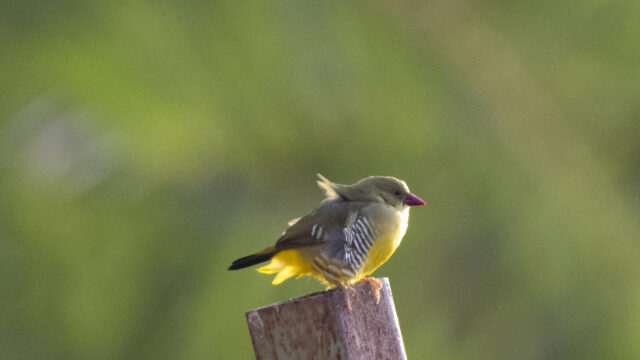In October 2018, Rajasthan Forest Department declared the Green Avadavat, or Green Munia, as the mascot of Mount Abu wildlife sanctuary. The bird has been declared a vulnerable species by the International Union for Conservation of Nature (IUCN) and has become rare in the subcontinent. This is probably the first time when a lesser-known endangered bird has been designated as a mascot to intensify protection efforts for wildlife and increase awareness among the masses.


The green avadavat, locally-known as Haria, is a passerine bird from the finch family. The bird is tiny, just around 4 inches long with bright green feathers on the back and a chrome yellow underbelly. It also has small black and white stripes on both sides just below the wings. The beak is short and bright red and stands out against the green and yellow feathers. The bird has a signature melodious call and moves in pairs and small groups. The word avadavat originated from Ahmedabad city which was once a centre of bird trade.

Shailesh Jain, a hotelier in Mount Abu, an ardent bird watcher and passionate about organic farming, first spotted a pair of green munia in 2017 in his farm. “When my caretaker, who belongs to the Bheel tribe, spotted the bird and whispered “haria”, I could not believe my eyes. I was so excited that we stopped weeding out the wild grass from the slopes of the farm to conserve and maintain the habitat where this little bird feeds on the grass seeds.” Since that day, it has become routine for Jain to track the behaviour of this beautiful bird.


“We have observed that this bird has a habit of using cow dung to bind its nest, so we stopped removing cow dung from the farm during nesting season. Our plan worked! Spotting the species was rare earlier but over the years they can be sighted more frequently moving in groups of 10-15. It is obvious that their number has grown over the years,” said Jain with a tinge of pride.

Jaipur-based bird expert Manoj Kulshrestha feels that the Green Munia has adapted to the habitat in Mount Abu quite well, especially around Peace park and near Gurushikhar. “The reason is awareness among the local community as well as the availability of broad-leaved grasses which they use for nesting and for seeds to feed upon.”

He feels that as long as the habitat is conserved and trapping is controlled, the Green Munia will continue to breed and can be saved like any other member of the finch family. “It needs grasses interspersed with small bushes in proximity to water or farms where sugarcane or other broad-leaved crops are grown.”


The bird is found mainly in the dry scrub regions, agricultural lands and close to water. Their largest numbers are present in central and north-western India.

Since this beautiful small bird is a rare sight everywhere, conservation of the vulnerable species can become a focal point to attract nature lovers, turning Mount Abu into a hotspot for wildlife enthusiasts and bird watchers. Apart from this little green species, Mount Abu is also known to have a sizable population of leopards, sloth bears and a host of other fauna and flora.




